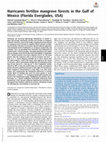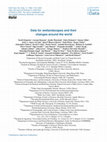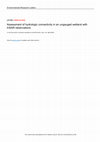Papers by Victor Rivera-monroy

Remote Sensing of Environment, 2021
The active hydrodynamics and complex circulation patterns in the northern Gulf of Mexico (nGoM) p... more The active hydrodynamics and complex circulation patterns in the northern Gulf of Mexico (nGoM) provide a dynamic scenario to investigate mesoscale responses of the size structure of phytoplankton communities to environmental variability. In this study, a large in-situ dataset acquired in inland, estuarine and coastal waters of the nGoM and U.S. East Coast were utilized to achieve a regional parameterization of the red-NIR ratio-based chlorophyll a (Chl a) algorithm for the high-spatial and spectral resolution Sentinel 3-OLCI ocean color sensor. Using an adaptive scheme, the algorithm was used in combination with other standard Chl a algorithms such as the Neural Network (C2RCC) and OC4ME to optimally extract Chl a in water types ranging from turbid estuarine to clear oceanic waters in the nGoM. This adaptive methodology (Chl a_AD) showed better performance in estimating OLCI-Chl a (R 2 =0.84, N = 178) compared to any single algorithm in the estuarine-coastal-ocean waters of the nGoM. Next, OLCI-derived phytoplankton spectral absorption coefficients (OLCI-a phy) were obtained for comparison, using a regionally-tuned 3rd order function of OLCI-Chl a based on Multi-regression (MR), and an estuarine-to-ocean adaptive Quasi-Analytical Algorithm (QAA-AD). Finally, an Empirical Orthogonal Function (EOF) algorithm was applied to OLCI-a phy to retrieve phytoplankton size fractions (PSFs) for the riverdominated nGoM region. Results indicate relatively better performance of MR-EOF in estimating f micro (R 2 =0.87), f nano (R 2 =0.76) and f pico (R 2 =0.64) compared to QAA-AD-EOF. Chl a time-series (Oct 2016-Jan 2020) obtained in the estuaries and shelf waters of the nGoM revealed seasonality (peak/lows in spring/fall) linked to river discharge, where hydrodynamics and wind driven variability due to storms further influenced the phytoplankton biomass spatiotemporal distribution. Microphytoplankton dominated in estuaries and the nGOM inner shelf waters, including the midshelf region during the spring peak river discharge period. PSF dynamics in the outer shelf is strongly influenced by Loop Current eddies where warm offshore waters contribute to the dominance of the picophytoplankton fraction. Floodwater discharge and strong winds due to Hurricane Barry (2019) transported estuarine microphytoplankton into the outer shelf and also increased nanophytoplankton fraction. Such fluctuations in phytoplankton size structure after hurricanes or storms can modify the pelagic food web dynamics in coastal systems.

Elsevier eBooks, 2011
The wide spatial distribution of wetlands (e.g., swamps, bogs, marshes, and mires) across differe... more The wide spatial distribution of wetlands (e.g., swamps, bogs, marshes, and mires) across different latitudes and geomor phological settings reflects their complex biotic and abiotic interactions that define their ecological function and high economic value. As space becomes more limited, and landscape fragmentation increases, competition over land area for development and related human activities will certainly limit management options/decisions related to the conservation and rehabilitation/restoration of wetland ecosystems, especially at large spatial scales. In this chapter, we draw information from multiple sources and experiences to compile a series of case studies to focus our attention on characterizing the direct and indirect causes of wetland degradation and loss, particularly in coastal regions. The examples used in this chapter include deltaic regions (Mississippi River Delta, Louisiana, USA; Grijalva-Mezcalapa-Usumacinta, Mexico; and Central Coast, Netherlands), islands (Puerto Rico), and karstic platforms (Everglades, FL, USA). Current estimates of global wetland area range from 6.8 to 10.1 million km 2 , which represents 5-8% of the Earth (56% in tropical and subtropical regions). Loss of approximately 50% of wetlands around the world indicates the significant effect of human activities. Practices such as Removal of Physical Materials from Systems: Loss of Space, Area, and Habitats excessive harvesting, hydrological modifications and seawall constructions, coastal development, and pollution are some of the most pressing causes of wetland loss. Similarly, inland wetlands have been impacted by constant hydrologic modification and agriculture and urban development. The examples presented in this chapter underline the dynamic interaction between human actions and wetland habitat reduction at local and global scales. These issues define well the scope of 'human use and abuses' of productive ecosystems vital for the sustainability of both poor and rich nations. However, present political, social, and economic structures in most of the coastal regions around the world are disconnected from the actual functioning of the natural environment in which they reside, hindering conservation of productive wetland ecosystems.
American Geophysical Union eBooks, Feb 1, 2016

Frontiers in Marine Science, Jun 27, 2023
Transport of riverine and wetland-derived dissolved organic carbon (DOC) spanning tidal wetlands,... more Transport of riverine and wetland-derived dissolved organic carbon (DOC) spanning tidal wetlands, estuaries, and continental shelf waters functionally connects terrestrial and aquatic carbon reservoirs, yet the magnitude and ecological significance of this variable and its spatiotemporal linkage remains uncertain for coastal deltaic regions, such as Mississippi River Delta Plain, which includes Mississippi (MR) and Atchafalaya (AR) rivers and estuaries with vast expanses of wetlands and coastal forests. We examined DOC dynamics and fluxes in this large river-dominated wetland-estuarine system for the period between 2019 and 2021 that included an extreme river flood event in 2019, two major hurricanes (Barry in 2019 and Ida in 2021), and cold front passage using an improved adaptive quasi-analytical algorithm (QAA-AD) applied to multi-satellite sensors (Sentinel 3A/B OLCI, Landsat-8/OLI and Sentinel-2A/B MSI) with varying spectral and spatial (10/30/300 m) resolutions. The DOC estimates from multi-satellite sensors in combination with water fluxes were used to assess DOC fluxes from two large rivers (MR and AR) and small channels across the delta plain. Overall, this system delivered a total of 6.7 Tg C yr-1 (1 Tg = 1012g) into the estuarine zone and the northern Gulf of Mexico (nGoM) during 2019. High DOC fluxes from the AR (1.3 Tg C yr-1) and MR (4.5 Tg C yr-1) were associated with the extreme flood event in 2019. Hurricanes that occurred in the study period also contributed to the wetland and estuarine DOC fluxes into continental shelf waters; for example, the passage of Hurricane Barry in July 2019, delivered over a 3-day period ~1.33 ×109 g DOC from Barataria Basin into the nGoM. Sentinel 2-MSI land and water classification revealed that Hurricane Ida eroded a total of 1.34×108 m2 of marshes in middle Barataria Basin, converting those habitats into open water with 3.0 m inundation depth and high DOC concentrations (16.4 mg L-1), a potentially large DOC source to the coastal waters. Overall, storms and flood events are major sources of DOC flux that facilitate transport of upstream carbon as well as transformation of carbon in the wetlands, through the conversion of vegetated wetland to open water.
Journal of Coastal Research, 2005
The goal of mangrove restoration projects should be to improve community structure and ecosystem ... more The goal of mangrove restoration projects should be to improve community structure and ecosystem function of degraded coastal landscapes. This requires the ability to forecast how mangrove structure and function will respond to prescribed changes in site conditions ...

Springer eBooks, 2017
This chapter focuses on the net primary productivity and carbon (C) dynamics of mangrove wetlands... more This chapter focuses on the net primary productivity and carbon (C) dynamics of mangrove wetlands as related to the potential to sequester atmospheric C in above- and belowground biomass and in the soil. We discuss the large variation in ecosystem properties across different coastal environmental settings and pay particular attention to global patterns of these ecosystem processes comparing the Atlantic-East-Pacific and Indo-West-Pacific biogeographic regions. Deltaic coasts have higher aboveground biomass (AGB) compared to other continental settings, but the highest average AGB was found in high oceanic islands. The global average rates of litter fall (NPPL) and (NPPW) wood production are about 6 t ha−1 yr−1 for aboveground net primary productivity (NPPA) of about 12 t ha−1 yr−1. The relative contribution of belowground allocation to soil C storage and wood production to total net primary productivity (NPPT) in mangrove wetlands has significant implications to net C exchange in these coastal forested wetlands. Examples are given to demonstrate that net ecosystem production (NEP) and net ecosystem carbon exchange for mangrove wetlands have implications to the debate on how coastal ecosystems influence the global C budget. Wood production is about 600 g dry mass m−2 yr−1 or about 300 gC m−2 yr−1. The average C sequestration in mangroves soils (∆Sorg) is about 224 gC m−2 yr−1. The sum of these two measures (NPPW + ∆Sorg) is an estimate of NEP at about 525 gC m−2 yr−1. A general conclusion based on these different approaches, and reviewing the existing global literature, is that NEP accumulates about 500 gC m−2 yr−1, equally distributed between wood production and soil C accumulation. The importance of above and belowground contributions to global estimates of C sequestration above- and belowground reinforces the need for a better understanding of biomass allocation in these systems. The net tidal exchange of inorganic and organic carbon is about 400 gC m−2 yr−1 with nearly equal distribution in these forms of carbon to coastal waters. It is not clear how the fate of this material may influence net carbon exchange in the coastal zone, which is a very active area of research. We also suggest that more information is needed on how the disturbance of mangrove wetlands, including their recovery, may influence net carbon flux in the coastal zone.

1) DESCRIPTION/ABSTRACT: It is assumed that to treat excess NO3- (> 30 μM), high soil organic ... more 1) DESCRIPTION/ABSTRACT: It is assumed that to treat excess NO3- (> 30 μM), high soil organic matter content (%OM) is required to maintain high denitrification rates in natural, created, or restored wetlands. However, this excess also represents a risk by increasing OM decomposition rates triggering peat collapse. Here, we evaluated the role of soil %OM and temperature interactions in controlling total and net denitrification rates using the isotope pairing and N2:Ar techniques in different habitats within eroding (Barataria Bay-BLC) and emerging (Wax Lake Delta -WLD) deltaic regions in coastal Louisiana. Soil and sediment cores were collected during summer, spring and winter (2015-2016) and incubated at close to in-situ temperatures (i.e., 30, 20 and 10 oC). Denitrification rates were linearly correlated with temperature with maximum mean rates (40.1–124.1μmol m-2 h-1) in the summer (30 oC) and lower (<26.2 ± 5.3 μmol m-2 h-1) in the winter (10 oC) seasons. Direct denitrifica...
Data on porewater salinity, temperature, conductivity, pH and redox have been collected to help e... more Data on porewater salinity, temperature, conductivity, pH and redox have been collected to help explain patterns found in porewater nutrient concentrations that were sampled in the same plots.
Data on porewater salinity, temperature, conductivity, pH and redox have been collected to help e... more Data on porewater salinity, temperature, conductivity, pH and redox have been collected to help explain patterns found in porewater nutrient concentrations that were sampled in the same plots.
We quantified how Hurricane Irma influenced soil nutrient pools, vertical accretion, and plant ph... more We quantified how Hurricane Irma influenced soil nutrient pools, vertical accretion, and plant phosphorus (P) uptake after its passage across the Florida Coastal Everglades in September 2017

Collaboration Across Boundaries for Social-Ecological Systems Science, 2019
Mangrove wetlands are one of the most threatened ecosystems in coastal zones, and are being degra... more Mangrove wetlands are one of the most threatened ecosystems in coastal zones, and are being degraded globally at a high rate due to human activities. Impoverished and vulnerable populations living in rural coastal areas in subtropical and tropical latitudes tend to be most directly dependent on ecosystem services and hence are directly affected by the degradation of mangrove wetlands and other coastal resources. We formed an interdisciplinary and international team of researchers, students, and professionals to understand the linkages between poverty traps and mangrove ecosystem services in coastal Tanzania, thus informing and contributing to institutional efforts to resolve and avoid these traps. This chapter analyzes the nature of this coupled natural-human system, assesses the challenges to implement an interdisciplinary research agenda as a team, and underscores the practical strategies to overcome those challenges.

Proceedings of the National Academy of Sciences, 2020
Hurricanes are recurring high-energy disturbances in coastal regions that change community struct... more Hurricanes are recurring high-energy disturbances in coastal regions that change community structure and function of mangrove wetlands. However, most of the studies assessing hurricane impacts on mangroves have focused on negative effects without considering the positive influence of hurricane-induced sediment deposition and associated nutrient fertilization on mangrove productivity and resilience. Here, we quantified how Hurricane Irma influenced soil nutrient pools, vertical accretion, and plant phosphorus (P) uptake after its passage across the Florida Coastal Everglades in September 2017. Vertical accretion from Irma’s deposits was 6.7 to 14.4 times greater than the long-term (100 y) annual accretion rate (0.27 ± 0.04 cm y−1). Storm deposits extended up to 10-km inland from the Gulf of Mexico. Total P (TP) inputs were highest at the mouth of estuaries, with P concentration double that of underlying surface (top 10 cm) soils (0.19 ± 0.02 mg cm−3). This P deposition contributed 49...

Geography and associated hydrological, hydroclimate and land-use conditions and their changes det... more Geography and associated hydrological, hydroclimate and land-use conditions and their changes determine the states and dynamics of wetlands and their ecosystem services. The influences of these controls are not limited to just the local scale of each individual wetland but extend over larger landscape areas that integrate multiple wetlands and their total hydrological catchment-the wetlandscape. However, the data and knowledge of conditions and changes over entire wetlandscapes are still scarce, limiting the capacity to accurately understand and manage critical wetland ecosystems and their services under global change. We present a new Wetlandscape Change Information Database (WetCID), consisting of geographic, hydrological, hydroclimate and land-use information and data for 27 wetlandscapes around the world. This combines survey-based local information with geographic shapefiles and gridded datasets of large-scale hydroclimate and land-use conditions and their changes over whole wetlandscapes. Temporally, WetCID contains 30-year time series of data for mean monthly precipitation and temperature and annual land-use conditions. The survey-based site information includes local knowledge on the wetlands, hydrology, hydroclimate and land uses within each wetlandscape and on the availability and accessibility of associated local data. This novel database (available through PANGAEA https://doi.org/10.1594/PANGAEA.907398; Ghajarnia et al., 2019) can support site assessments; cross-regional comparisons; and scenario analyses of the roles and impacts of land use, hydroclimatic and wetland conditions, and changes in whole-wetlandscape functions and ecosystem services.

Ecosphere, 2017
Large Mississippi River (MR) diversions (peak water flow >1416 m 3 /s and sediment loads >165 kg/... more Large Mississippi River (MR) diversions (peak water flow >1416 m 3 /s and sediment loads >165 kg/s) have been proposed as part of a suite of coastal restoration projects and are expected to rehabilitate and rebuild wetlands to alleviate the significant historic wetland loss in coastal Louisiana. These coastal wetlands are undergoing increasing eustatic sea-level rise, land subsidence, climate change, and anthropogenic disturbances. However, the effect of MR diversions on wetland soil organic carbon (SOC) sequestration in receiving basins remains unknown. The rate of SOC sequestration or carbon burial in wetlands is one of the variables used to assess the role of wetland soils in carbon cycling and also to construct wetland carbon budgets. In this study, we examined the effects of MR water and sediment diversions on landscape-scale SOC sequestration rates that were estimated from vertical accretion for the next 50 yr (2010-2060) under two environmental (moderate and less optimistic) scenarios. Our analyses were based on model simulations taken from the Wetland Morphology model developed for Louisiana's 2012 Coastal Master Plan. The master plan modeled a "future-without-action" scenario as well as eight individual MR diversion projects in two of the hydrologic basins (Barataria and Breton Sound). We examined the effects that discharge rates (peak flow) and locations of these individual diversion projects had on SOC sequestration rates. Modeling results indicate that large river diversions are capable of improving basin-wide SOC sequestration capacity (162-222 g CÁm À2 Áyr À1) by up to 14% (30 g CÁm À2 Áyr À1) in Louisiana deltaic wetlands compared to the future-without-action scenario, especially under the less optimistic scenario. When large river diversions are placed in the upper receiving basin, SOC sequestration rates are 3.7-10.5% higher (6-24 g CÁm À2 Áyr À1) than when these structures are placed in the lower receiving basin. Modeling results also indicate that both diversion discharge and location have large effects on SOC sequestration in low-salinity (freshwater and intermediate marshes) as compared to high-salinity marshes (brackish and saline marshes).

Environmental Research Letters, 2018
The Ciénaga Grande de Santa Marta (CGSM) is one of the world's most productive tropical wetlands ... more The Ciénaga Grande de Santa Marta (CGSM) is one of the world's most productive tropical wetlands and one that has witnessed some of the greatest recorded dieback of mangroves. Human-driven loss of hydrologic connectivity by roads, artificial channels and water flow regulation appears to be the reason behind mangrove mortality in this ungauged wetland. In this study, we determined the CGSM's current state of hydrologic connectivity by combining a remote sensing technique, termed as Wetland Interferometric Synthetic Aperture Radar (InSAR), with a hydrologic study of river water discharge. For this research, we processed 29 ALOS-PALSAR acquisitions taken during the period 2007-2011 and generated 66 interferograms that provide information on relative surface water level changes. We found that change in water discharge upstream on the main tributary of the CGSM could explain at most 17% of the variance of the change in water level in the CGSM. Fresh water inputs into the wetland were identified only when the mean daily water discharge in the river exceeded 700 m 3 s −1 , which corresponds to only 30% of the days during the period. The interferogram analysis also revealed that artificial channels within the wetland serve as barriers to water flow and contribute to the overall loss in hydrologic connectivity. We recommend increasing fresh water inputs from the Magdalena River by reducing water regulation of fresh water from the river and improving connectivity on either side of the artificial channels crossing the CGSM. This study emphasizes the potential of the application of wetland InSAR to determine hydrologic connectivity in wetlands that are completely or poorly ungauged and to define the necessary guidelines for wetland hydrologic restoration.
This material is based upon work supported by the National Science Foundation through the Florida... more This material is based upon work supported by the National Science Foundation through the Florida Coastal Everglades Long-Term Ecological Research program under Cooperative Agreements #DBI-0620409 and #DEB-9910514. This image is made available for non-commercial or educational use only.
This material is based upon work supported by the National Science Foundation through the Florida... more This material is based upon work supported by the National Science Foundation through the Florida Coastal Everglades Long-Term Ecological Research program under Cooperative Agreements #DBI-0620409 and #DEB-9910514. This image is made available for non-commercial or educational use only.
This material is based upon work supported by the National Science Foundation through the Florida... more This material is based upon work supported by the National Science Foundation through the Florida Coastal Everglades Long-Term Ecological Research program under Cooperative Agreements #DBI-0620409 and #DEB-9910514. This image is made available for non-commercial or educational use only.









Uploads
Papers by Victor Rivera-monroy